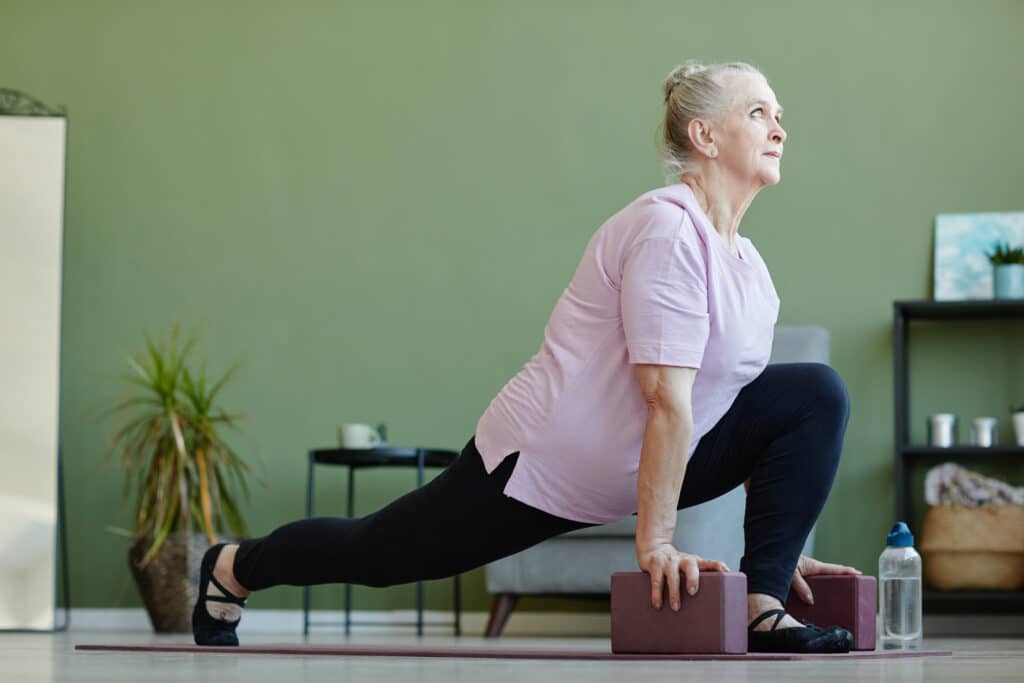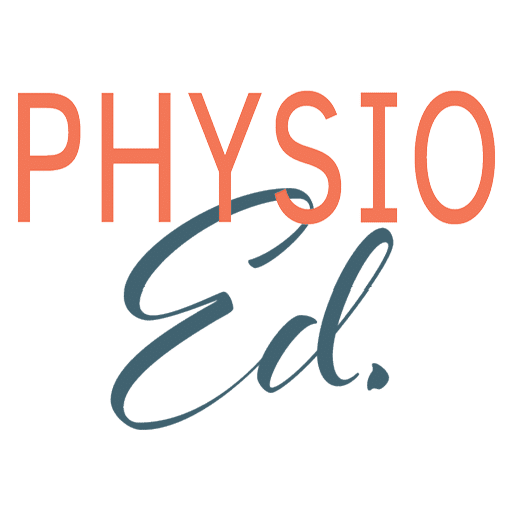Welcome to our exploration of hip extension—an essential exercise for adults of any age. In a society that is becoming more sedentary by the year, hip extension exercises are great for counteracting some of the impacts of sitting in a chair or on the couch all day.
Hip extension exercises target the glutes, the muscles that make up your buttocks. This huge muscle group provides power, strength, and stability. Despite the importance of this group of exercises, many people fail to reap the full benefits due to one common issue: poor form.
In this article, we’ll delve into why hip extension is crucial for adults and highlight how improper form can hinder its effectiveness.
Understanding the fundamentals and focusing on the correct technique can maximize the benefits of hip extension exercises and enhance your overall fitness journey. Let’s dive in!
Anatomy of the Hip Joint

Let’s start by delving into the intricate workings of the hip joint. Understanding its anatomy gives you a solid foundation for optimizing hip extension and addressing issues.
Your hip joint is a ball-and-socket joint, allowing for a wide range of motion in various directions. It comprises the femur (thigh bone) and the acetabulum (socket in the pelvis). The muscles surrounding this joint make the hips’ dynamic and multi-directional movement possible.
The primary players in hip extension are the gluteus maximus, hamstrings, and adductor muscles. Though not directly attached to the structures that make up the hip joint, the muscles in your lower back also play an essential role in stabilizing the pelvis during standing hip extension.
These muscles all work together to propel your leg backward, which is necessary for walking, running, stair climbing, and standing up from a seated position.
Hip Extension Mechanics
Now, let’s talk mechanics. Hip extension is more than just swinging your leg backward; it involves a coordinated effort of muscles and proper form.
Hip extension involves the movement of your leg backward from your hip joint. Understanding its biomechanics in both “closed chain” and “open chain” scenarios can show how your body moves.
Closed Chain Movements
In simple terms, closed chain hip extension occurs when your foot is in contact with the ground, such as during activities like walking or squatting.
In this scenario, the force generated by your muscles is transmitted through your leg and into the ground, providing stability and power for movements like pushing off the ground when you walk or rise from a squat.
Open Chain Movements
On the other hand, open chain hip extension happens when your foot is free to move, like when you’re doing kickbacks. In open chain hip extension, your pelvis stays stable while the femur and the rest of your leg are mobile.
In this case, the force generated by your muscles primarily moves your leg without the same level of stability and ground reaction forces as in closed chain movements.
The Role of Your Glutes
While both closed and open-chain hip extension exercises are beneficial, understanding their biomechanics can help you choose the right exercises for your fitness goals and maximize the benefits of each movement.
Your gluteus maximus takes center stage in hip extension, whether you are performing an open or closed chain movement or firing up to push your thigh back. But it doesn’t work alone; the muscles at the back and inner part of your thigh and lower back also support this movement.
It’s also important to understand that your anterior (front) hip musculature must be flexible to achieve functional hip extension. In older adults, limited hip extension range of motion is a common problem, often attributed to tight hip flexors and weak glutes.3
In short, if the fronts of your hips feel tight—from sitting too often, for example—and the backs of your hips are weak or uncoordinated, you will have a limited hip extension.
The Benefits of Improving Hip Extension

Improving your hip extension goes beyond just enhancing your athletic performance; it can significantly impact your overall well-being.
A Remedy for the Effects of Sedentary Living
As we’ve mentioned a few times up until now, strengthening your hip extensors can be crucial to healthy movement patterns. This has become even more important recently as sedentary lifestyles have become increasingly common.1,2
I have seen a growing number of patients in my clinic with extremely weak hip extensors who report spending up to twelve waking hours a day sitting.
Improved Strength, Performance & Posture
Optimizing hip extension can increase strength, power, and agility, making everyday activities like climbing stairs or carrying groceries easier and safer. Enhanced hip extensor strength also contributes to better posture and stability.
These muscles are crucial in maintaining proper pelvis and spine alignment, reducing the risk of lower back pain and injuries associated with poor posture.
With weak hip extensors, you may tend to lean forward or develop an anterior pelvic tilt, which can cause severe postural abnormalities and muscle imbalances if not addressed.
Moreover, strong hip extensors are essential for optimizing athletic performance and functional movements. Whether you’re running, jumping, or lifting heavy objects, powerful hip extensors provide the necessary propulsion and stability to perform these activities efficiently and safely.
Heading Off Injuries Before They Occur
Focusing on hip extension can help prevent common injuries, such as lower back pain and hip impingement, by promoting better movement mechanics and reducing joint stress.
Strong hip flexors benefit joints such as the knees and ankles by providing better support and alignment during dynamic movements. This can help prevent overuse injuries and promote longevity in physical activity participation.
Improved Balance and Coordination
Improved hip extensor strength can enhance balance and coordination, which is vital for activities such as walking on uneven terrain or navigating stairs, especially as we age.
Hip extensor strength is integral for maintaining independence and quality of life as we age. It enables us to perform everyday tasks easily and confidently, from bending down to picking up objects to getting up from a seated position without assistance.
Common Issues & Corrective Strategies

So now you know that you likely need to perform some hip extension exercises to reap the benefits, but how? What if you’re struggling with hip extension when you’ve tried to perform these exercises in the past?
Many people face challenges such as tight hip flexors, weak glutes, or poor movement patterns that hinder their ability to extend their hips fully and properly.
The good news is that there are corrective strategies you can implement to address these issues. Here are a few things to keep in mind when you begin to perform these exercises:
Focus on pelvic stability
Ensure that your pelvis remains stabilized throughout the exercise to avoid compensatory movements from the lower back. Engage your core muscles and imagine a slight tuck of your tailbone to maintain a neutral pelvic position. This will help direct the movement from the hip joint rather than relying on excessive lumbar extension.
A Note on Extension
Lumbar extension is when you have a more pronounced arch in your lower back.
Typically, this position indicates pelvic instability, especially gluteal and core inactivity or weakness. Before doing any heavy lifting or strenuous movement, it’s best to find a more neutral position by “tucking” your tailbone to try to find a slightly flatter low back.
This stabilized position requires glute and core engagement to stabilize your pelvis for safer, more efficient movement.
Start with Small Movements
This is one of my patients’ biggest common mistakes when they start hip extension exercises. Remember that hip extension has a relatively small average range of motion, even in healthy adults.
When you start learning to find hip extension, don’t expect large movements. Instead, focus on initiating the movement from your glutes and hamstrings while keeping the rest of your body stable.
Quality of movement is vital, so start with smaller ranges of motion and gradually increase your exertion as you build flexibility, strength, and control.
Stretch Regularly
Incorporate stretching exercises targeting the hip flexors to improve flexibility and reduce tightness. Try kneeling hip flexor stretches, lunges, or yoga poses like the low lunge to release tension in the hip flexor muscles and allow for better hip extension. The image at the top of this section illustrates a yoga lunge with blocks as an aid.
Your hip flexors directly oppose your hip extensors, so if they are too tight, you won’t be able to work through the full range of motion.
Check Your Alignment: Maintain proper alignment throughout the exercise by keeping your shoulders relaxed, spine neutral, and hips level. Avoid overarching or rounding your lower back, as this can strain your spine unnecessarily and diminish the exercise’s effectiveness. Visualize a straight line from your head to your tailbone to ensure proper alignment.
Emphasize Muscle Activation: Focus on contracting your glutes and hamstrings to drive hip extension. Squeeze your glutes at the top of the movement to maximize muscle activation and ensure a full range of motion. Mind-muscle connection is crucial, so concentrate on engaging the target muscles throughout the exercise for optimal results.
Exercises to Improve Hip Extension
Now, let’s get moving! Incorporating specific close-chained exercises into your routine can help you improve hip extension and reap its many benefits.
Open Chain Movements for Beginners
You can start with the basic “open chain” movements below to keep things safe and simple. These help activate glute muscles that might have been dormant for a while.
For my older adult patients, I typically start with the following exercises. I ensure they maintain their form to activate their muscles properly before moving on to more compound movements.
Donkey Kicks
- Start on your hands and knees in a tabletop position, with your wrists aligned under your shoulders and your knees under your hips.
- Engage your core to stabilize your spine.
- Keeping your right knee bent at a 90-degree angle, flex your right foot and lift your knee towards the ceiling, driving through your heel.
- Squeeze your glutes at the top of the movement, then lower your knee with control. Repeat on the left side.
Common Form Issues: Avoid arching your lower back or letting your hips sway to one side during the movement. Keep your core engaged and your spine neutral throughout. Focus on lifting your leg with control using the glutes rather than relying on momentum.
Prone Hip Extension
- Lying face down on the floor, cushion your head on your hands with your legs extended straight behind you.
- Lift one leg until you feel the muscles at the back of your hip engage.
- Repeat this movement on the same leg until you begin to feel a sense of fatigue in your gluteal muscles
- Repeat on the opposite side.
Common Form Issues: Patients will often only lift their lower leg (shin) in this movement. However, you need to make sure you are also lifting your thigh off the ground. It’s also important to be aware of whether your glutes are doing the work or if your low back is taking over. You should feel your hip muscles working with your low back assisting them, not the other way around.
Standing Hamstring Curls
- Start by standing before a chair, wall or countertop to aid in balance.
- Lift on foot off the ground and bend your knee as if you’re trying to touch your heel to your butt.
- Ensure that the knee of your lifted leg remains parallel with or even slightly behind that of your standing leg.
- Repeat this movement several times until you feel a sense of fatigue at the back of your thigh.
- Repeat on the other leg
Common Form Issues: Avoid arching your lower back during the movement. Keep your pelvis neutral and focus on using your hamstrings to lift your foot toward your glute. Control the movement throughout the entire range of motion to maximize effectiveness.
Closed Chain Movements for Hip Extension
Hip thrusts, deadlift variations, glute bridges, and lunges are just a few exercises that effectively target hip extension.
We will start with simpler floor exercises and provide more advanced options for more experienced exercisers. By performing these exercises with proper form and gradually increasing intensity, you can strengthen the muscles involved in hip extension and enhance your overall functional fitness.
Glute Bridges
- Lie on your back with your knees bent and feet flat on the ground, hip-width apart.
- Engage your core and press through your heels to lift your hips off the ground until your body forms a straight line from shoulders to knees.
- Squeeze your glutes at the top of the movement, then lower your hips with control.
Common Form Issues: Avoid overarching your lower back or letting your knees fall outward during the movement. Keep your pelvis level throughout and focus on engaging the glutes to lift your hips rather than relying on momentum.
Heels Elevated Hip Thrusts
- Place your heels on a secure surface like a bench with you back flat on the ground
- With bent knees, drive your heels into the bench and lift your hips as high as possible
- You should feel a strong contraction in your hamstrings and glutes.
- Lower back to the starting position. Repeat for 10-12 repetitions. Rest before completing a second set.
Common Form Issues: Avoid overarching your lower back or allowing your knees to cave inward during the movement. Ensure your spine remains neutral throughout, and engage your core to prevent excessive lumbar extension.
Hip Hinge
- Stand with your feet hip-width apart.
- Hinge at your hips and bend your knees slightly as you lower your chest towards the ground, keeping your back straight and chest up.
- Push through your heels and drive your hips forward to return to standing, squeezing your glutes at the top.
- This exercise can be done with a chair for support or free-standing with your hands on your hips.
Common Form Issues: Watch out for lower back rounding or lifting with the back instead of the hips. Focus on driving through your heels to effectively engage your backside.
Lunges
- Stand tall with your feet together and step forward with one foot, lowering your body until both knees are bent at 90-degree angles.
- Keep your front knee aligned with your ankle and your back knee hovering just above the ground.
- Push through your front heel to return to the starting position, then repeat on the other side.
Common Form Issues: Watch out for leaning too far forward or allowing your front knee to collapse inward during the lunge. Keep your torso upright and engage your core to maintain stability throughout the movement.
By performing these exercises properly and gradually increasing intensity, you can effectively target the muscles involved in hip extension and enhance your overall functional fitness. Remember to start with lighter weights or resistance and master the movement pattern before progressing to heavier loads.
Incorporating Hip Extension into Your Fitness Routine
Hip extension shouldn’t be an afterthought in your fitness routine—it should be a priority. Regularly incorporating hip extension exercises into your workouts can improve overall movement quality, reduce the risk of injury, and enhance your performance in various activities.
Your glutes, hamstrings, and adductors are all big muscles, and the more often you perform exercises to target and isolate them, the more likely they will activate during your daily movements.
Start by including a mix of isolated hip extension exercises in your routine, focusing on proper form and technique. As you progress, gradually increase the intensity and volume of these exercises and add a few compound movements to continue challenging your muscles and promoting further improvements in hip extension.
Summary
Hip extension exercises are essential for adults to counteract the sedentary lifestyle impacts, targeting the glutes for power, strength, and stability. Poor form can diminish the benefits of these exercises, emphasizing the importance of proper technique.
The hip joint’s anatomy, involving the ball-and-socket structure, facilitates a wide range of motion, with the gluteus maximus, hamstrings, and adductor muscles playing key roles in hip extension. Differentiating between closed and open chain movements helps tailor exercises to fitness goals.
Addressing common issues like tight hip flexors and weak glutes is crucial for effective hip extension. Incorporating both open and closed chain exercises can enhance hip extension, improving mobility, reducing injury risks, and supporting overall well-being. Prioritizing hip extension in fitness routines can lead to significant improvements in movement quality and life quality.
Key Takeaways
- Hip extension exercises combat sedentary lifestyle effects, focusing on glute strength and stability.
- Understanding hip anatomy and mechanics is crucial for optimizing exercises and correcting poor form.
- Differentiating between closed (foot in contact with the ground) and open (foot free to move) chain movements allows for targeted exercise selection.
- Common problems like tight hip flexors and weak glutes can limit hip extension, requiring focused corrective strategies.
- Incorporating various hip extension exercises, such as donkey kicks, prone hip extension, glute bridges, and lunges, can effectively address these issues.
- Regularly including hip extension exercises in fitness routines enhances overall movement quality, reduces injury risk, and improves quality of life.
References
- Javaid, F., Ahmad, S., & Sharif, F. (2022). EFFECTS OF A SEDENTARY LIFESTYLE ON HIP EXTENSION AMONG GENERAL POPULATION. Pakistan Journal of Physical Therapy (PJPT).
- Moradi, Z., Akbari, M., Ansari, N. N., Emrani, A., & Mohammadi, P. (2014). Strength of hip muscle groups in sedentary women with patellofemoral pain syndrome. Journal of back and musculoskeletal rehabilitation, 27(3), 299-306.
- Lee, L. W., Zavarei, K., Evans, J., Lelas, J. J., Riley, P. O., & Kerrigan, D. C. (2005). Reduced hip extension in the elderly: dynamic or postural?. Archives of physical medicine and rehabilitation, 86(9), 1851-1854.
- Qiu, J., Zhou, T., Jin, H. et al. Effect of adding hip exercises to general rehabilitation treatment of knee osteoarthritis on patients’ physical functions: a randomized clinical trial. BMC Sports Sci Med Rehabil 15, 158 (2023). https://doi.org/10.1186/s13102-023-00772-7








